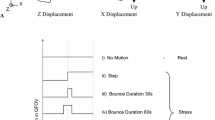Abstract
Due to the long imaging times in SPECT, patient motion is inevitable and constitutes a serious problem for any reconstruction algorithm. The measured inconsistent projection data lead to reconstruction artifacts which can significantly affect the diagnostic accuracy of SPECT if not corrected. Among the most promising attempts for addressing this cause of artifacts is the so-called data-driven motion correction methodology. But even this algorithm is restricted to the correction of abrupt rigid patient motion and exclusive correction of gradual motion, which may lead to unsatisfactory results. In this note we present for the first time a motion correction approach which overcomes the mentioned restrictions. The new approach is based on the super-resolution methodology. To demonstrate the performance of the proposed scheme, corrections of abrupt and gradual motion are presented.
Access this chapter
Tax calculation will be finalised at checkout
Purchases are for personal use only
Preview
Unable to display preview. Download preview PDF.
Similar content being viewed by others
References
Wheat JM, Currie GM. Incidence and characterization of patient motion in myocardial perfusion SPECT: Part 1. J Nucl Med Technol 2004;32(2):60–65.
Botvinick EH, Zhu YY, O’Connell WJ, Dae MW. A quantitative assessment of patient motion and its effect on myocardial perfusion SPECT images. J Nucl Med 1993;34(2):303–310.
Cooper JA, Neumann PH, McCandless BK. Effect of patient motion on tomographic myocardial perfusion imaging. J Nucl Med 1992;33(8):1566–1571.
Friedman J, van Train K, Maddahi J, Rozanski A, Prigent F, Bietendorf J, et al. “Upward creep” of the heart: A frequent source of false-positive reversible defects during thallium-201 stress-redistribution SPECT. J Nucl Med 1989;30(10):1718–1722.
Pellot-Barakat C, Ivanovic M, Weber DA, Herment A, Shelton DK. Motion detection in triple scan SPECT imaging. IEEE Trans Nucl Sci 1998;45(4):2238–2244.
Passalaqua AM, Narayanaswamy R. Patient motion correction of SPECT images: dual scan approach. IEEE Proc NSSS’94, Norfolk, VA 1995;3:1270–1274.
Lee KJ, Barber DC. Use of forward projection to correct patient motion during SPECT imaging. Phys Med Biol 1998;43:171–187.
Chen QS, Franken PR, Defrise M, Jonckheer MH, Deconinck F. Detection and correction of patient motion in SPECT imaging. J Nucl Med Technol 1993;21(4):198–205.
Fulton RR, Eberl S, Meikle SR, Hutton BF, Braun M. A practical 3D tomographic method for correcting patient head motion in clinical SPECT. IEEE Trans Nucl Sci 1999;46(3):667–672.
Kyme AZ, Hutton BF, Hatton RL, Skerrett DW, Barnden LR. Practical aspects of a data-driven motion correction approach for brain SPECT. IEEE Trans Med Imag 2003;22(6):722–729.
Vogel CR, Oman ME. Fast numerical methods for total variation minimization in image reconstruction. Procs SPIE 1995.
Hanke M, Nagy JG, Vogel C. Quasi-Newton approach to nonnegative image restoration. Linear Algebra and its Applications 2000;316:223–236.
Nocedal J, Wright SJ. Numerical Optimization. Springer; 1999.
Author information
Authors and Affiliations
Editor information
Editors and Affiliations
Rights and permissions
Copyright information
© 2007 Springer-Verlag Berlin Heidelberg
About this paper
Cite this paper
Schumacher, H., Fischer, B. (2007). A New Approach for Motion Correction in SPECT Imaging. In: Horsch, A., Deserno, T.M., Handels, H., Meinzer, HP., Tolxdorff, T. (eds) Bildverarbeitung für die Medizin 2007. Informatik aktuell. Springer, Berlin, Heidelberg. https://doi.org/10.1007/978-3-540-71091-2_11
Download citation
DOI: https://doi.org/10.1007/978-3-540-71091-2_11
Publisher Name: Springer, Berlin, Heidelberg
Print ISBN: 978-3-540-71090-5
Online ISBN: 978-3-540-71091-2
eBook Packages: Computer Science and Engineering (German Language)




